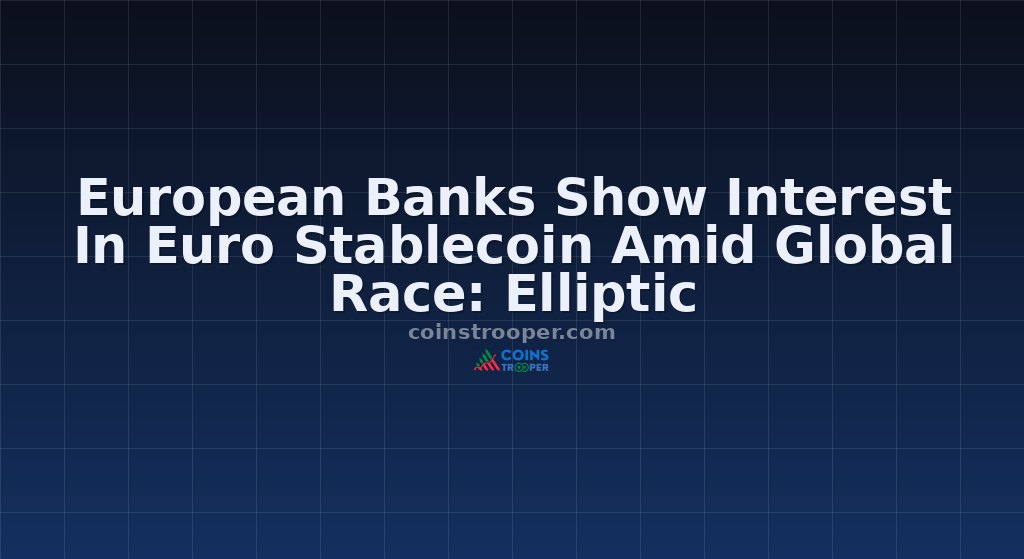European Banks Show Interest In Euro Stablecoin Amid Global Race: Elliptic

- But while the intent is promising, questions remain over whether Europe can act swiftly enough to compete with the U.S.
- and Asia, where regulatory clarity and market adoption are already accelerating, Aruliah said.
- The banking consortium includes ING, Banca Sella, KBC, Danske Bank, DekaBank, UniCredit, SEB, CaixaBank, and Raiffeisen Bank International.
- This step could provide a much-needed alternative to dollar-backed stablecoins, which currently dominate the market.
What Happened
A consortium of European banks is reportedly exploring the launch of a euro-denominated stablecoin, showing the industry’s growing appetite for tokenized assets and digital money.
Market Context
But while the intent is promising, questions remain over whether Europe can act swiftly enough to compete with the U.S. and Asia, where regulatory clarity and market adoption are already accelerating, Aruliah said.
This step could provide a much-needed alternative to dollar-backed stablecoins, which currently dominate the market. Yet without urgency and scale, experts warn Europe risks ceding ground to overseas competitors.
The Markets in Crypto-Assets Regulation (MiCA) offers Europe a robust legal framework, while progress on the digital euro provides a complementary initiative. However, translating these frameworks into adoption requires coordination between policymakers and financial institutions.
Aruliah argues that the first jurisdictions to move decisively will set the global standards and capture the lion’s share of capital flows. For Europe, the next few years will be key.
Why It Matters
European banks are beginning to wake up to the potential of a euro-backed stablecoin, a move that could mark a turning point for the region’s financial system, according to Mark Aruliah, Head of EMEA Policy and Regulatory Affairs at blockchain analytics firm Elliptic.
Aruliah from Elliptic notes that banks are eager to engage. “European banks have shown their appetite to engage with stablecoins and tokenized assets, but they need clear regulatory pathways and the right tools to manage risk,” he said.
“News that a consortium of European banks is exploring a euro stablecoin is a positive signal, but it must be matched by scale, urgency, and more clarity on regulatory expectations,” Aruliah added.
“If European banks don’t move quickly to adopt and scale credible euro-denominated stablecoins in a robust and safe way, there is a real risk that dollar-backed alternatives will continue to dominate by default.”
The European Central Bank (ECB) has already raised alarms about the region’s overreliance on U.S. dollar-based stablecoins. Without credible euro-backed offerings, the ECB fears Europe could see its financial infrastructure increasingly dependent on foreign products.
A competitive euro stablecoin could strengthen the euro’s international role, support financial development, and enhance resilience against overdependence on dollar-backed products.
If European banks and regulators act decisively, the region has a chance to reclaim ground in the stablecoin race. If not, it risks being left behind in a dollar-dominated future.
Details
Growing Appetite for Digital Assets
The banking consortium includes ING, Banca Sella, KBC, Danske Bank, DekaBank, UniCredit, SEB, CaixaBank, and Raiffeisen Bank International.
Pressure from Global Peers
Across the Atlantic, the U.S. has taken major strides toward developing regulated stablecoins, while regulators in Asia, including Singapore’s Monetary Authority (MAS) and the Hong Kong Monetary Authority (HKMA), are moving decisively to shape frameworks and encourage adoption.
ECB Concerns Loom Large
Such a development would weaken the region’s monetary sovereignty and influence in global finance, explains Aruliah.
Europe’s Chance to Lead
The post European Banks Show Interest in Euro Stablecoin Amid Global Race: Elliptic appeared first on Cryptonews.

